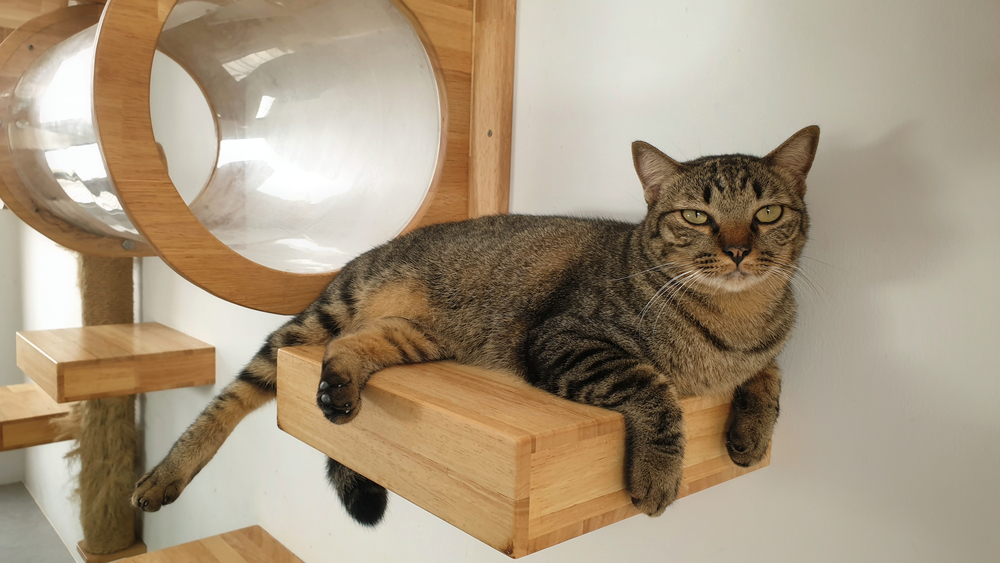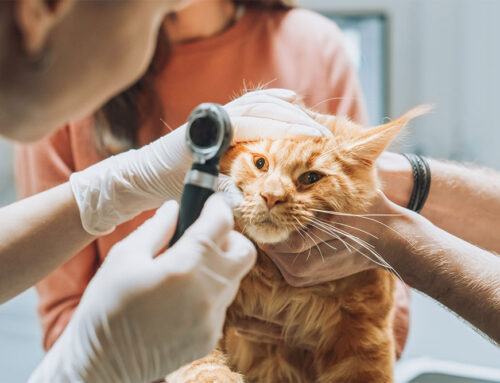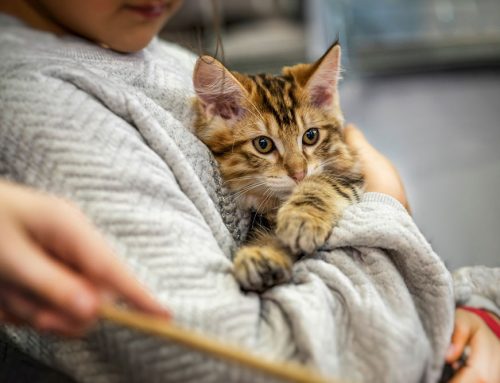Is your cat a creature of habit by choice or necessity?
While dogs can explore the world, go to training classes, and enjoy a wide selection of chew toys and games, cats are often left to their own devices for entertainment and personal satisfaction. Unfortunately, the indoor cat’s restricted lifestyle limits their options to engage in meaningful cat-specific behavior. This does not stop many cats from trying, but when they do, their climbing, scratching, and stalking are considered inappropriate.
Feline enrichment can easily improve your cat’s emotional and physical health by providing variety, novelty, and safe opportunities for natural behaviors. Livingston Veterinary Hospital has created a starter’s guide to get your cat engaged right away.
Let your cat climb
Safe climbing opportunities allow your cat to expand their territory, feel secure from perceived or real threats, and comfortably observe their surroundings. Climbing is a fun and healthy exercise for cats that can boost their balance, fitness, and self-confidence. Create safe perches from furniture by adding a cozy bed or non-slip matting, or keep your cat off your shelves, dressers, and desk by providing a cat tree.
Let your cat hide
Cats hide for many reasons—they may be wary, frightened, and need to escape, or they may feel safer in seclusion, and slink behind furniture so they do not draw attention. Hiding helps cats feel secure, and allows them to watch their environment without feeling exposed or vulnerable.
Take a look at your home’s design, and ensure your cat has places from which they can easily appear or disappear.
Let your cat stalk
Cats learn as kittens to observe, stalk, chase, pounce, and manipulate their prey, and they perform these behaviors throughout their lives. In the absence of natural prey, indoor cats may respond to your moving feet and other pets, or knock stationary objects from elevated surfaces.
Encourage your cat to practice healthy stalking behavior with toys that move erratically, such as feather wands, motorized mice, or motion-activated toys. Cats must be able to catch and manipulate their prey to feel successful, so avoid laser pointers, which can result in frustration and demotivate your playful cat. Remove the toy after playing, or switch toys around, to prevent your cat from losing interest.
Let your cat play
Feline play can be solitary, or interactive with a fellow cat or human. While adult cats are less playful than kittens, they can often be encouraged to play. Each cat has their own play preferences and style, so do not be discouraged if your initial attempts do not trigger a playful response. Try some inexpensive DIY toys, and use your cat’s predatory behaviors for inspiration. Keep play sessions brief, and right before meal time, to increase your cat’s energy and interest.
Let your cat scratch
Scratching is important to your cat’s health, despite seeming like a damaging, nuisance behavior. Scratching allows cats to stretch their entire body, literally from the tips of their toes to their tail. Stretching promotes healthy spinal extension and flexibility, so your cat can jump and land safely. Scratching also maintains your cat’s nail health by shedding the outer nail covering, and allowing new growth.
A cat scratching post or scratching mat can provide a safe alternative for your cat to scratch their stress away. The post should be tall enough to allow your cat to stretch their entire body. Sprinkle catnip on the new accessory, and watch your cat fall in love.
Let your cat hunt
Feeding your cat from a bowl may be convenient for you, but it’s not the most rewarding experience for a dignified hunter like your cat. While cats in the wild hunt for food, your cat’s meals can simulate scavenging and foraging behavior. The “seeking” behavior is intrinsically rewarding for many animal species, including cats, and can promote satisfaction, physical exercise, and better rest.
Introduce easy food challenges first, ensuring your cat can successfully access the food.
Frustrated cats may quit trying, and go without food, which is not healthy.
Let your cat explore

Cats are neophilic (i.e., they love new or novel things), but unfortunately for most cats, the home environment rarely changes. Mix things up by occasionally introducing new objects to your cat’s familiar space. Keep them basic and non-threatening, such as cardboard boxes in different sizes or styles, and in new textures, such as crumpled packing paper, shredded paper, or a fuzzy rug. Let your cat explore the new item at their own pace, and then take it away.
If you’re feeling adventurous, many social cats can be harnessed and leash trained, to safely explore the great outdoors. We do not recommend trying this with a nervous or shy cat.
The key to feline enrichment
While enrichment can be limitless, do not feel intimidated by all these options. Try one or two at a time, and see how your cat responds. The quality of your cat’s experience is more important than the quantity, because trying too many things at once can easily stress your cat and have the opposite effect.
Remember to let your cat be your guide, and have fun. If you have additional questions about your cat’s behavioral health, contact our Livingston Veterinary Hospital team.







Leave A Comment